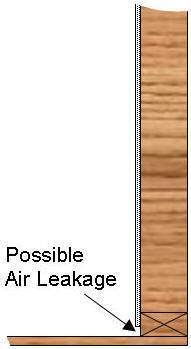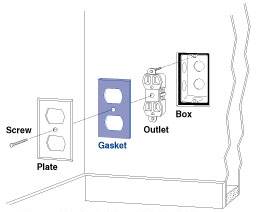Living Spaces
- Exterior Walls:
Air remediation on exterior walls is best performed on the inside of the home. This maybe a contradiction to many do-it-yourself instructions, they are trying to take the easy way out, but air remediation is much more effective when performed on the inside of the wall, secondarily caulk and other materials will have a longer life when applied in a controlled environment.
Sealing voids and gaps on the exterior of the home does protect the structure from potential damage caused by rain.

Figure 1 - Air leakage at baseboards.
- Windows
- Window and Door Frame Voids:
The space behind baseboards see Figure 1, that resides on the interior side of an exterior wall can also be an area that allows for air leakage within the home. To remedy this area the best solution is to remove the baseboard and fill the void with expanding foam or as needed.
As an alternative you can use caulking that is either clear or accepts paint along both the top and bottom edge of the baseboard.
Do not forget to seal any outside or inside angles and any seams that might exist along the horizontal plane of the baseboard.
Obvious air leakage areas such as broken or cracked glass in windows should be replaced. Depending on how aggressively you wish to approach window air remediation there are different levels of sealing.
The most beneficial method of sealing window frames is to remove the inner trim around the windows and fill any voids with expanding foam. This not only provides sealing but insulation as well. If removing the window trim is a greater exercise than you are willing to undertake, consider laying a small bead of clear or silicone caulk (caulk that can be painted can also be used) around the edges of both sides of the interior window trim.
The area between the base of the door threshold and the foundation is a common area for air to exit or enter your home.
The best remediation is accomplished by removing the threshold, apply a caulking to the base of the foundation and then setting the threshold into the caulking. As an alternative you can lay a bead of caulking on the edges of the threshold.

Figure 3: Install gaskets behind cover plates for all electrical receptacles and switches including those on interior walls. It is always wise to turn off the power before installing the gaskets.
- Electrical Boxes:
- Water and Drain Pipes:
- Fireplaces:
With respect to air remediation around the door frame it requires the same efforts as a window frame.
If your threshold uses a rubber or vinyl strip to aid sealing the bottom of the door, it may need replacement.
Additional air remediation may be obtained by installing a door sweep on the base of the door.
Electrical boxes that are mounted on exterior walls should have gaskets applied between the cover plate and the box (Figure 3).
An area that is prone for air leakage is the entry point for water and drain pipes under kitchen and bathroom sinks and the water line for any toilets.
Use caulk or expanding foam to seal these interior penetration points.
Fireplace flues and chimneys are always an area where air escapes and enters a home. If you do not use your fireplace consider installing a permanent plug in the flue. If you use your fireplace ensure that the damper is working properly and that it is in the closed or off position when the fireplace is not in use. The addition of fireplace glass doors will provide additional sealing.
Apply the appropriate caulk to the area where the chimney butts to the wall, by either caulking the trim on both sides or removing the trim and caulking beneath it.
